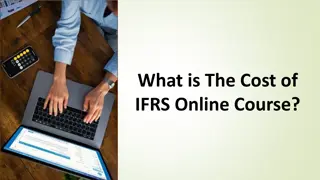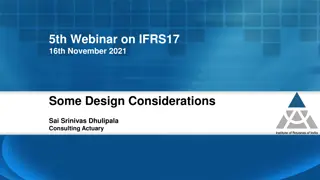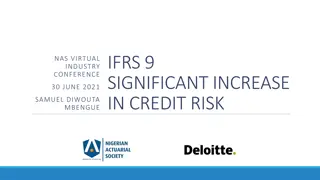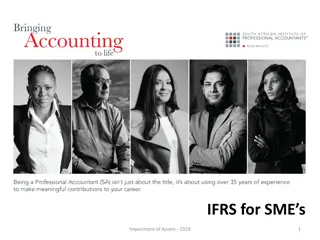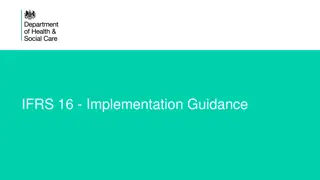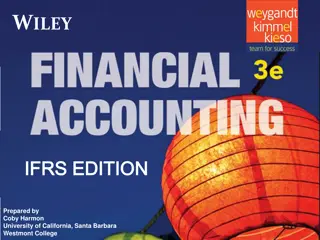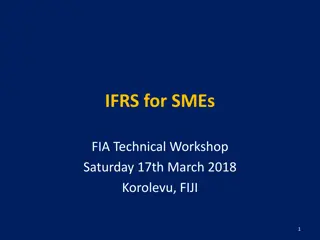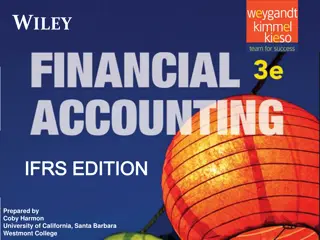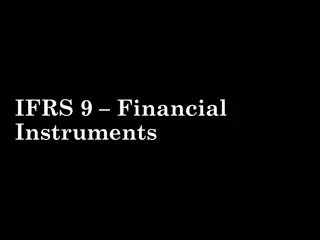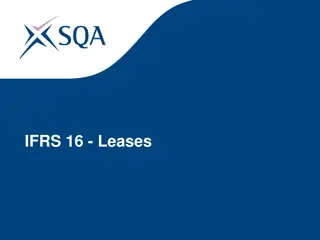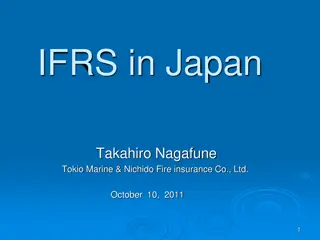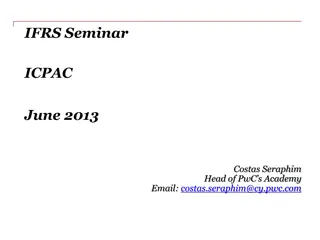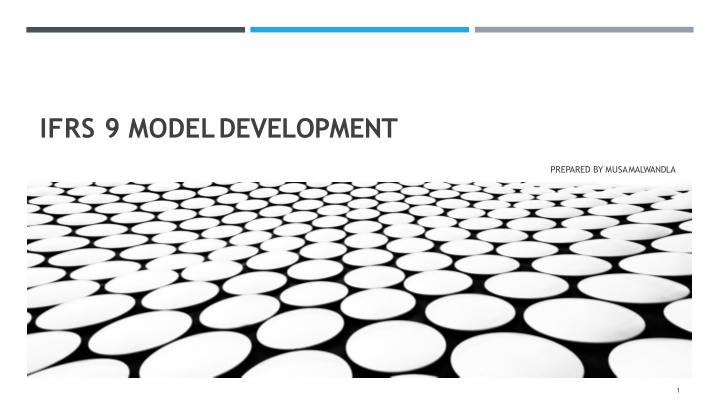
IFRS 9 Model Development Overview in Industry Trends and Approaches
Explore the development of IFRS 9 models prepared by Musa Malwandla, including insights on exposure at default, loss given default, probability of default, credit loss, and more. Gain an overview of IFRS 9, industry trends, and modeling approaches, shedding light on ECL provisions, credit losses, balance sheet components, and the segmentation scheme. Understand the differences between the incurred loss and expected loss philosophies, and discover the stages in IFRS 9 for classifying loan performance.
Download Presentation

Please find below an Image/Link to download the presentation.
The content on the website is provided AS IS for your information and personal use only. It may not be sold, licensed, or shared on other websites without obtaining consent from the author. If you encounter any issues during the download, it is possible that the publisher has removed the file from their server.
You are allowed to download the files provided on this website for personal or commercial use, subject to the condition that they are used lawfully. All files are the property of their respective owners.
The content on the website is provided AS IS for your information and personal use only. It may not be sold, licensed, or shared on other websites without obtaining consent from the author.
E N D
Presentation Transcript
IFRS 9 MODEL DEVELOPMENT PREPARED BY MUSAMALWANDLA 1
OVERVIEW OF IFRS 9 INDUSTRYTRENDS MODELLING APPROACHES AGENDA 2
IN ANUTSHELL: Exposure Given Default [EAD] Loss Given Default [LGD] Probability of Default [PD] Credit Loss [ECL] The loss to be incurred some ? The likelihoodof moving into default over some horizon (analogous to ???) The loanbalance at the point of default The proportionof the principal-at- risk that islost over horizon 3
IN ANUTSHELL: ECL provisions CreditLosses Equity GrossLoans &Advances Net Loans& Advances Liabilities OtherAssets Loss Distribution Balance Sheet 4
BACKGROUND ONIAS39 Incurred lossphilosophy: Provisions only required to recognize expected losseson impairments that have alreadyoccurred. Impairment Provisions vs InterestRates 10.2% 130 Provisions only account for the current lossevent. 10.0% 120 9.8% 110 9.6% Segmentation scheme: 100 9.4% Specific provisions (for knownlosses). 9.2% 90 9.0% General provisions (for unknown losses /IBNR). 80 8.8% 70 8.6% 60 8.4% Weaknesses: 8.2% 50 CalendarTime Backward-looking: not reactive to changing macro µ. Impairment Provision Interest Rate -Actual Interest Rate: 1-YearForecast Imprudent: does not account for future lossevents. Unpredictive:does notuse allavailable data. Illustration 6
OVERVIEW OFIFRS9 Expected lossphilosophy: Provisions recognize expected losses, regardlessof occurrence. Impairment Provisions vs InterestRates 10.2% 130 Level of prudence depends on level ofdeterioration. 10.0% 120 9.8% 110 9.6% 100 9.4% Segmentation scheme: 9.2% 90 Three-stage segmentation, based on level ofdeterioration. 9.0% 80 8.8% 70 8.6% Strengths: 60 8.4% 8.2% 50 CalendarTime Forward-looking: pre-emptively account for futurelosses. Impairment Provision Interest Rate -Actual Interest Rate: 1-YearForecast More prudent: accounts for future (lifetime) lossevents. More Predictive: use moredata. Illustration 7
OVERVIEW OFIFRS9 STAGE I ? ? ? = ? ?1 2 ? ? ? ? ? ? Loans still performing inline with origination expectations STAGE II ? ? ? = ? ?? ? ? ? ? ? ? ? ? ? Pre-default loans where the outlook has deteriorated since origination STAGEIII ? ? ? = ? ? ? ? ? ? Loans that arein default 8
SICR analysis forstaging Forecasting behavioural accountlifetime PD modelling with a variable outcomeperiod TECHNICAL CHALLENGES OF IFRS9 PD modelling with time-varying macrocovariates EAD modelling with variabletime-to-default ECL with probability-weighted scenarios 10
CRITICISMS Governance aroundforecast: ECL results rely heavily onforecast assumptions. Challenge of aligning ECLacross institutions. Allows management to control the levelof provisions. Ambiguousdefinitions: Definition ofSICR. Data required to develop SICR onlong- datedexposures. Macroprudentialconcerns: IFRS provisioning schememight exacerbate macro shocks.
CYCLICALITY: TYPICALCYCLE Source: Coronavirus: Accounting Standard IFRS 9 Coronavirus Crisis is NOT Financial Crisis 2008 , valuesque.com 12
CYCLICALITY: COVID19 CYCLE Source: Coronavirus: Accounting Standard IFRS 9 Coronavirus Crisis is NOT Financial Crisis 2008 , valuesque.com 13
Alignment: IFRS 9 behavioural lifetimevs treasury liquidity model. IFRS 12-month ECL vs Basel III EL. WIDER IMPLICATIONS ECL macro scenarios vs ICAAPstress scenarios? Additional resources: Historical data needed to implement aSICR analysis. External forward-looking data for ECLmodelling. 14
IAS 39APPROACHES Model Type Applications Variable Outcome Period Time Varying Covariates Logistic Regression PD Decision Tree PD Accelerated Lifetime PD, LGD Cox Regression PD, LGD Linear Regression EAD, LGD 16
PROPOSED APPROACH: PD MODEL FORM Behavioural score,e.g., driven by creditscore Hazardrate ofdefault ?,?= ? ??+ ??+ ?? Link function, e.g., probit,logit, Coxian Credit riskindex Baselinehazard function 17
PROPOSED APPROACH: PD MODEL INTUITION Note: This is a generalisation ofCox regression in discretetime. Deleting credit risk index and selecting a Coxian linkfunction produces a Coxregression. Step 1:Term-Structure Step 2: Term Structure +Behavioural Score Step 3: Term Structure + Behavioural Score + CreditIndex 18
BASELIN E HAZARD BaselineHazard Cycle0 Baseline Hazard Cycle3 120 60% % 50% 100 40% % 30% 80% 20% 60% 10% 40% 0% 20% 1 0% 7 13 19 25 31 1 7 13 19 25 3 1 Baseline hazard represents theimpact distance-to-default on default hazard rates. TIME SINCEOBSERVATION TIME SINCEOBSERVATION Estimated Graduated(95%) E stimated Graduated(96.89%) Exposures that are far fromdefault (e.g., up-to-date loans) will see are curve that is initiallyupward-sloping. BaselineHazard Cycle2 BaselineHazard Cycle1 The definition of default being usedwill thus influence the shape ofthe baseline hazard. 80% 70% 60% 90% 80% 70% 60% 50% 40% 30% 20% 10% 0% 50% 40% 30% Actuarial graduation can be usedto smooth the crude baselinehazard rate. 20% 10% 0% 1 7 13 19 25 31 1 7 13 19 25 31 TIME SINCEOBSERVATION TIME SINCEOBSERVATION Estimated Graduated(99.24%) Estimated Graduated(98.87%) 19
Behavioural Risk Index(Zero-Mean) BEHAVIOURAL SCORE 40% 30% 20% 10% 0% -10% -20% -30% -40% 4 5 6 1 2 3 7 8 9 Behavioural score is the output from an internal or external credit scoring model. BEHAVIOURAL RISKGROUP Cycle1 Cycle2 Cycle0 Cycle3 Scores with higher discriminatory power produce a greater slope inthe behavioural risk index. Behavioural RiskIndex 90% 80% 70% 60% 50% 40% 30% 20% 10% 0% -10% 4 5 6 1 2 3 7 8 9 BEHAVIOURAL RISKGROUP Cycle 1 Cycle2 Cycle0 Cycle3
MacroeconomicModel Cycle3 MacroeconomicModel Cycle0 CREDITRISK INDEX 40% 30% 20% 10% 0% -10% -20% -30% -40% 40% 30% 20% 10% 0% -10% -20% Represents the influence ofexogenous factors on defaulthazard. EVENTMONTH EVENTMONTH Macroeconomic Risk Index(Target) Predicted Predicted Macroeconomic Risk Index(Target) Influenced by macroeconomics, internal policy, regulations etc. We can use a macroeconomic time series regression model to smoothand forecast the credit riskindex. MacroeconomicModel Cycle2 MacroeconomicModel Cycle1 70% 60% 50% 40% 30% 20% 10% 0% -10% -20% 70% 60% 50% 40% 30% 20% 10% 0% -10% -20% EVENTMONTH EVENTMONTH Macroeconomic Risk Index(Target) Predicted Predicted Macroeconomic Risk Index(Target) 21
CREDIT RISK INDEX Standar d Error VarianceInflation Factor Model R-Square RMSE Variable Estimate P-Value Cycle0 40.17% 5.51% Intercept -2.04522 0.33443 0.00% 0.00000 CPI 0.01912 0.00406 0.00% 1.00743 ConsumptionToGDP 0.03264 0.00556 0.00% 1.00743 Cycle1 44.39% 6.82% Intercept -3.02841 0.44050 0.00% 0.00000 Variables included in the macroeconomic regression must: Prime 0.01046 0.00307 0.10% 1.08119 ConsumptionToGDP 0.04930 0.00744 0.00% 1.08119 Have probability-weighted forecasts available, for calculating ECL. Cycle2 65.02% 7.41% Intercept -4.94748 0.47290 0.00% 0.00000 Make sense within the context of themodel. Prime 0.01999 0.00328 0.00% 1.04688 Be included at lags and leads, where appropriate andpractical. ConsumptionToGDP 0.07962 0.00795 0.00% 1.04688 Ideally align with those used in other applications (e.g., ICAAP process). Cycle3 32.15% 7.45% Intercept -3.01481 0.53193 0.00% 0.00000 mev_GDP -0.01219 0.00246 0.00% 1.14080 mev_ConsumptiontoGDP 0.05237 0.00898 0.00% 1.14080 Attrition 88.39% 4.16% Prime 0.36556 0.02033 0.00% 0.00000 DebtToIncome -0.04862 0.00183 0.00% 1.00000 22
? ? ? ? ? ? ? ? ? ? ? ? ? ? ? ? ? ? ? ? =? ? ? ? ? ? ? ? ? @ ? ? ? ? 0 MOVING FROM HAZARD TOPD ? ? ? ? ? ? ? ? ? ? ? ? ? [ ? ? ? ? ? ? ? ? ? ? ? ?????] ? ? ? ? ? ? Survivor s at Start Defaul t Hazar d Attritio n Hazard Survivor s at End Cumulativ e Defaults Probabilit y of Default Time Defaults Settlement s 1 2 3 4 5 6 7 8 9 100.00 99.65 98.56 96.49 94.95 93.47 92.07 90.74 89.47 88.26 87.12 86.03 85.00 84.01 83.07 82.20 81.38 80.61 79.88 78.49 77.12 75.78 74.46 73.16 0.00 0.00 0.25% 1.00% 2.00% 1.50% 1.45% 1.40% 1.35% 1.30% 1.25% 1.20% 1.15% 1.10% 1.05% 1.00% 0.95% 0.90% 0.85% 0.80% 0.75% 0.70% 0.65% 0.60% 0.55% 0.50% 0.00% 0.00% 0.10% 0.10% 0.10% 0.10% 0.10% 0.10% 0.10% 0.10% 0.10% 0.10% 0.10% 0.10% 0.11% 0.12% 0.10% 0.10% 0.10% 0.10% 1.00% 1.05% 1.10% 1.15% 1.20% 100.00% 0.00% 0.00% 0.25 1.00 1.97 1.45 1.38 1.31 1.24 1.18 1.12 1.06 1.00 0.95 0.89 0.84 0.79 0.74 0.69 0.64 0.60 0.55 0.50 0.45 0.41 0.37 0.00 0.00 0.10 0.10 0.10 0.10 0.09 0.09 0.09 0.09 0.09 0.09 0.09 0.09 0.09 0.10 0.08 0.08 0.08 0.08 0.79 0.82 0.84 0.87 0.89 72.79 0.00 0.00 99.65 98.56 96.49 94.95 93.47 92.07 90.74 89.47 88.26 87.12 86.03 85.00 84.01 83.07 82.20 81.38 80.61 79.88 78.49 77.12 75.78 74.46 73.16 0.00 0.00 0.00 0.25 1.25 3.22 4.66 6.04 7.35 8.59 9.77 10.89 11.95 12.95 13.90 14.79 15.63 16.42 17.16 17.85 18.50 19.10 19.65 20.15 20.60 21.01 21.38 21.38 21.38 0.3% Process of calculating PDs requires that we have an attrition hazardmodel. 1.2% 3.2% 4.7% Attrition hazard models behavioural lifetime a simpler version of PD model can beused. 6.0% 7.4% 8.6% In order to use contractual life,instead of behavioural life, attrition rate is: 9.8% 10.9% 10 11 12 13 14 15 16 17 18 19 20 21 22 23 24 25 26 12.0% ? = 0 ? < ? ? ? ? ? ? ? ? ? ? ? ? ? ? ? ? ? ? ? = ? ? ? ? ? ? ? ? ? ? ? ? ? ? ? ? ? ? ? Attrition hazard and default hazardare combined through competing-risk survival analysis. 12-monthPD 13.0% ? 1 13.9% 14.8% 15.6% 16.4% 17.2% 17.9% Process is identical that which isused in multi-decrement mortality tables. Contractual lifetime of24 months 18.5% 19.1% 19.6% 20.1% 20.6% LifetimePD 21.0% 21.4% 21.4% 23 21.4%
VALIDATION PD by Horizon: Cycle0 PD by Horizon: Cycle1 16% 14% 12% 10% 8% 6% 4% 2% 0% 50% INTERTEMPORALACCURACY 40% 30% 20% 10% 0% 1 6 11 16 21 26 31 36 1 6 11 16 21 26 31 36 We can validate accuracy byoutcome period: HORIZON HORIZON ObservedPD IFRS9PD CoxPD ObservedPD IFRS9PD CoxPD Ensures there is no bias for long/shorter outcome periods. We can validate calendar time: PD (Horizon = 12) by Calendar Month: Cycle0 PD (Horizon = 12) by Calendar Month: Cycle1 14% 45% 40% 35% 30% 25% 20% 15% 10% 5% 0% Ensures there is no bias across the economic cycle. 12% 10% 8% i.e., model will be accuracy during downturns and upturns! 6% 4% 2% 0% OBSERVATIONMONTH OBSERVATIONMONTH Observed PD IFRS9PD Observed PD IFRS9PD CoxPD CoxPD 25
VALIDATION IFRS9GiniStatisticbyHorizon AccuracyAccrossRange:Cycle0,Horizon 12 50% 45% 40% 35% 30% 25% 20% 15% 10% 5% 0% 60% 50% CROSS-SECTIONALACCURACY 40% Observed 30% 20% 10% 0% 5% 10% 15% 20% 25% 30% 35% 40% 45% 0% Cross-sectional accuracy ensures that the model accuracy will be maintained evenif the risk mix is changed (e.g., due to strategy). Predicted 6 12 18 24 36 48 Cycle 0 Cycle1 Cycle2 Cycle3 IFRS9 Cox Similarly, we must ensure that the model maintains discriminatory power acrossthe economic cycle. AccuracyAccrossRange:Cycle0,Horizon 12 IFRS9 Gini Statistic by Cycle overTime 25% 60% 50% 20% 40% Observed 15% 30% 10% 20% 5% 10% 0% 0% 0% 2% 4% 6% 8% 10% 12% 14% 16% 18% 200701 200704 200707 200710 200801 200804 200807 200810 200901 200904 200907 200910 201001 201004 201007 201010 201101 201104 201107 201110 201201 201204 201207 201210 201301 201304 201307 201310 201401 201404 Predicted IFRS9 Cox 0 1 2 3 26
RevolvingProducts Amortising Products Approach: regression model for CCF orLEQ Approach: Amortisation equation at contractualrates ? ? ?? , ? ????? ? + ?? ? ? ?? , ? = ? ?? + ? ?? ? ? ? ? ?, ??, ?? where: where: ? ? ?? , ? is expected EAD, conditioned ondefault at time ?. ?? is the contractual instalment amount on theloan. ?? is the contractual term on theloan. ? ? is thetime-to-defaulton theloan. ?? is the distance-to-default on the loan, i.e., how many payments must be missed before defaultoccurs. ? ? ?? , ? is expected EAD, conditioned ondefault at time ?. ? ? is thetime-to-defaulton theloan. ?? and ?? are behaviouraland macro drivers,resp. ? ?? and ? ?? are thedrawn and undrawn portions of thecredit facility. EADAPPROACHES 27
PROPOSED APPROACH:ECL ? = ?, ?? , 1 ?, ?? , 1 ? ? ?? , ? ? ? ?? , ? ? ??? ? 1 , ? ?=1 ? ?=1??? , ? ? 2 ?, ?? , 2= ?, ?? , 2 ? ? ?? , ? ? ? ?? , ? ? ? ?? ?,?? , ? ? ?? ? = ? =1 ?? ? 3 ? = ?, ?? , 3 ?, ?? , 3 ? ? ?? , ? ? ? ?? , ? ? ??? , ? ?=1 28
PD LGD Result Accurate Accurate Ever-downdefinition1 Stilldown Single-eventLGD2 LifetimeLGD Ever-downdefinition LifetimeLGD Overstates ECL Stilldown Single-eventLGD Understates ECL 1. 2. Ever-down definition means default is an absorbingstate Single-event LGD only models losses related to the currentdefault. 29
Expected CreditLoss Cashflow SurvivalAnalysis Calculate expected lifetime losses as limit ofsurvival curve Perform a survival analysis where the unitof analysis is outstandingbalance ? ??,?= 1 ?,???, ?? ?=0 ? ? ?? = ??, where: where: ? ? ?? is the lifetime expected credit loss on the account, as of time ? Related to survival analysis with long-termsurvivors . ??,?is theoutstanding balance attime ?, as a % of current exposure ?? and ?? are behaviouraland macro drivers,resp. ?,?is the hazard function representing rate of payment or recoveries FURTHER THOUGHTS DIRECT APPROACH 30
TRANSITION ANALYSIS: IMPACTS Impairment Coverage overTime Pre-COVID Imapirment Coverage byStage 4.0% 45.0% 42.8% 3.5% 39.9% ~80b 36.8% 3.0% 2.5% 2.0% 1.5% 9.1% 9.0% 1.0% 6.3% 5.0% 0.5% 0.7% 0.6% 0.6% 0.4% 0.0% ABG FSR NED SBK 1992 1993 1994 1995 1996 1997 1998 1999 2000 2001 2002 2003 2004 2005 2006 2007 2008 2009 2010 2011 2012 2013 2014 2015 2016 2017 2018 2019 2020 Stage1 Stage3 Stage2 32
TRANSITION ANALYSIS: STAGING Pre-COVID19 StageProfile 4% 4% 4% 4% 5% 5% 6% 6% 6% 8% 8% 11% 6% 14% 14% 15% 15% 5% 9% 8% 8% 9% 12% 6% 12% 15% 10% 9% 8% 13% 12% 11% 90% 89% 87% 87% 87% 86% 86% 84% 82% 82% 81% 81% 78% 74% 75% 73% ABG FSR NED SBK ABG FSR NED SBK ABG FSR NED SBK ABG FSR NED SBK PersonalLoans VAF Card Mortgages Stage 3 Stage1 Stage2 33
COVID19 IMPACT:STAGING COVID19 StageProfile 5% 6% 7% 7% 8% 8% 8% 8% 9% 10% 12% 14% 17% 7% 18% 19% 19% 10% 12% 8% 12% 12% 12% 15% 7% 18% 14% 6% 13% 12% 15% 15% =-3% =-6% =-8% =-5% 88% 83% 83% 82% 81% 81% 80% 80% 80% 78% 77% 75% 70% 70% 66% 66% FSR NED FSR NED ABG SBK ABG FSR NED SBK ABG SBK ABG FSR NED SBK PersonalLoans VAF Card Mortgages Stage 3 Stage1 Stage2 34
COVID19 IMPACT:COVERAGE COVID-19 ImpairmentImpact COVID Change inCoverage 1.7% 2.0% 1.5% 1.0% 0.5% 0.0% -0.5% -1.0% -1.5% -2.0% -2.5% -3.0% 60% 54% 1.1% 48% 0.8% 50% 0.4% 0.3% 0.2% 41% 0.1% 0.0% 39% 40% 34% 32% 30% -0.6 % -0.9% 20% -2.1% 10% -2.6% ABG FSR NED SBK 0% Stage2 Stage 1 Stage 3 ABG FSR NED SBG INL CPI 35
COVID19 IMPACT: ASSET GROWTH Total Loans & Advances,YoY 30% 25% 20% 15% 10% 5% 0% Jul-93 Jul-94 Jul-95 Jul-96 Jul-97 Jul-98 Jul-99 Jul-00 Jul-01 Jul-02 Jul-03 Jul-04 Jul-05 Jul-06 Jul-07 Jul-08 Jul-09 Jul-10 Jul-11 Jul-12 Jul-13 Jul- Jan- Jan- Jan- Jan- Jan- Jan- Jan- Jan- Jan- Jan- Jan- Jan- Jan- Jan- Jan- Jan- Jan- Jan- Jan- Jan- Jan- Jan- 92 93 94 95 96 97 98 99 00 01 02 03 04 05 06 07 08 09 10 11 12 13 -5% 36


